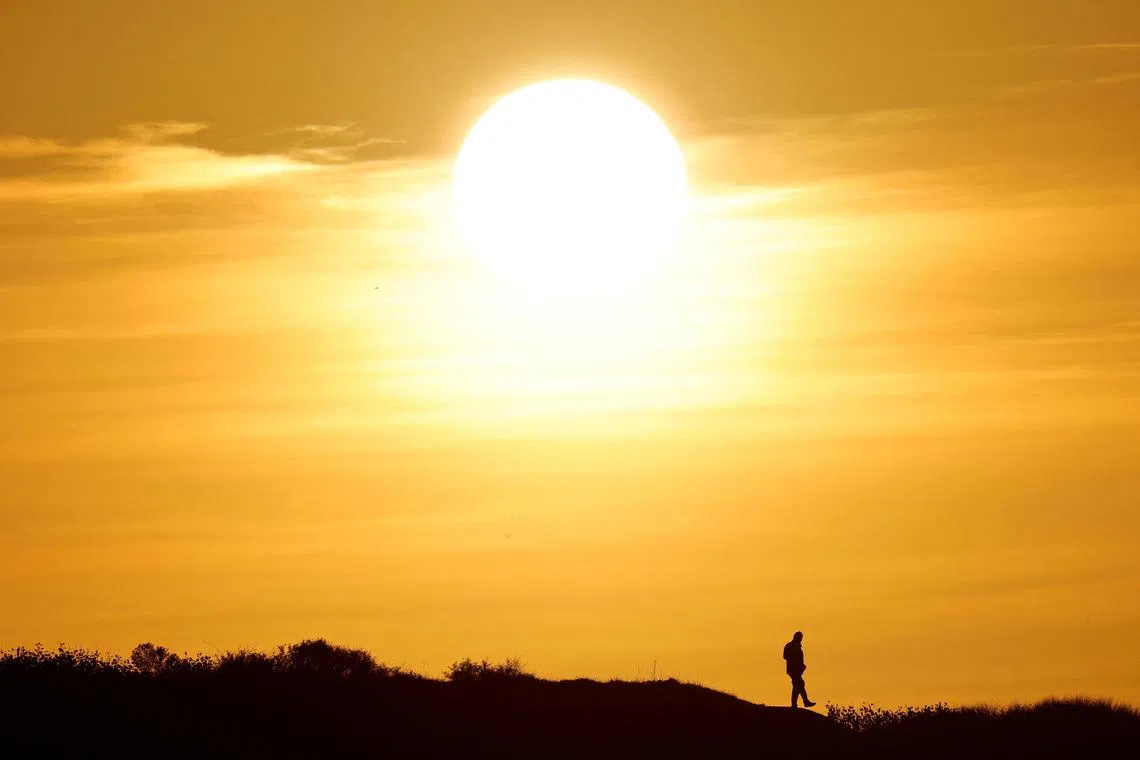UN confirms 2022 among eight hottest years on record
Sign up now: Get ST's newsletters delivered to your inbox

2022 tied with 2015 as the fifth-warmest year since record-keeping began in 1880.
PHOTO: REUTERS
Follow topic:
GENEVA - The past eight years were the hottest since records began, the United Nations has confirmed, despite the cooling influence of a drawn-out La Nina weather pattern.
In 2022, as the world faced a cascade of unprecedented natural disasters made more likely and deadly by climate change, the average global temperature was about 1.15 deg C above pre-industrial levels, the World Meteorological Organisation (WMO) said on Thursday.
The US National Oceanic and Atmospheric Administration and Nasa released similar 2022 global temperature figures on Thursday, and Mr Bill Nelson, head of the US space agency, described them as alarming.
“Forest fires are intensifying, hurricanes are getting stronger, droughts are wreaking havoc, sea levels are rising,” Mr Nelson said. “Extreme weather patterns threaten our well-being across this planet. And we need some bold action.”
The WMO, a UN agency, said the past eight years “were the warmest on record globally, fuelled by ever-rising greenhouse gas concentrations and accumulated heat”.
The hottest year on record was 2016, followed by 2019 and 2020, it found.
The year 2022 also marked the eighth consecutive year that annual global temperatures were at least 1 deg C over the pre-industrial levels seen between 1850 and 1900.
The Paris Agreement, agreed to by nearly all the world’s nations in 2015, called for capping global warming at 1.5 deg C, which scientists say would limit climate impacts to manageable levels.
But the WMO warned on Thursday that “the likelihood of – temporarily – breaching the 1.5 deg C limit... is increasing with time”.
Dr Russell Vose, chief of climate monitoring at the National Oceanic and Atmospheric Administration, said there is a 50-50 chance that there will be a year in the 2020s where global warming will be above 1.5 deg C, although a sustained average of 1.5 deg C warming is not projected to occur until the late 2030s or 2040s.
The WMO reached its conclusions by consolidating six leading international data sets, including those from the National Oceanic and Atmospheric Administration and the European Union’s Copernicus climate monitor.
The UN agency highlighted that the warmest eight years on record had all been since 2015, despite consecutive La Nina events since 2020. The weather phenomenon has a cooling effect on global temperatures.
The year 2022 was, therefore, just the fifth- or sixth-hottest year ever recorded.
The situation in 2022 was more extreme in some places.
Copernicus said in its annual report on Tuesday that the planet’s polar regions experienced record temperatures last year, as did large swathes of the Middle East, China, central Asia and northern Africa.
Europe endured its second-hottest year ever as France, Britain, Spain and Italy set new average temperature records, and heatwaves across the continent were compounded by severe drought conditions, it said.
For the planet as a whole, the WMO said the impact of La Nina, which is expected to end within months, would be short-lived.
The weather pattern, it said, “will not reverse the long-term warming trend caused by record levels of heat-trapping greenhouse gases in our atmosphere”.
The WMO said the trend was clear: “Since the 1980s, each decade has been warmer than the previous one.”
The average temperature for the period 2013-2022 was 1.14 deg C above the pre-industrial baseline.
It stood at 1.09 deg C between 2011 and 2020, according to estimates by the UN’s Intergovernmental Panel on Climate Change.
This, the WMO said, “indicates that long-term warming continues”, with the world “already approaching the lower limit of temperature increase the Paris Agreement seeks to avert”.
Like Nasa’s Mr Nelson, WMO’s chief Petteri Taalas highlighted extreme weather events in 2020, pointing to floods that submerged a third of Pakistan, record-breaking heatwaves in China, Europe and the Americas, and a drawn-out drought in the Horn of Africa.
At the COP27 climate summit in November, UN chief Antonio Guterres unveiled a five-year, US$3 billion (S$4 billion) plan to build a global early warning system for deadly and costly extreme weather events amplified by climate change.
So far, only half of the 193 UN member states have such systems, Mr Taalas said.
Dr Gavin Schmidt, director of Nasa’s Goddard Institute for Space Studies, said collective action is needed now, but that it is never going to be too late to make better decisions.
“Future warming is a function of future emissions of carbon dioxide,” Dr Schmidt said. “At any point in the future, we can decide to do something that will reduce the emissions and reduce the temperatures in the future.” AFP

